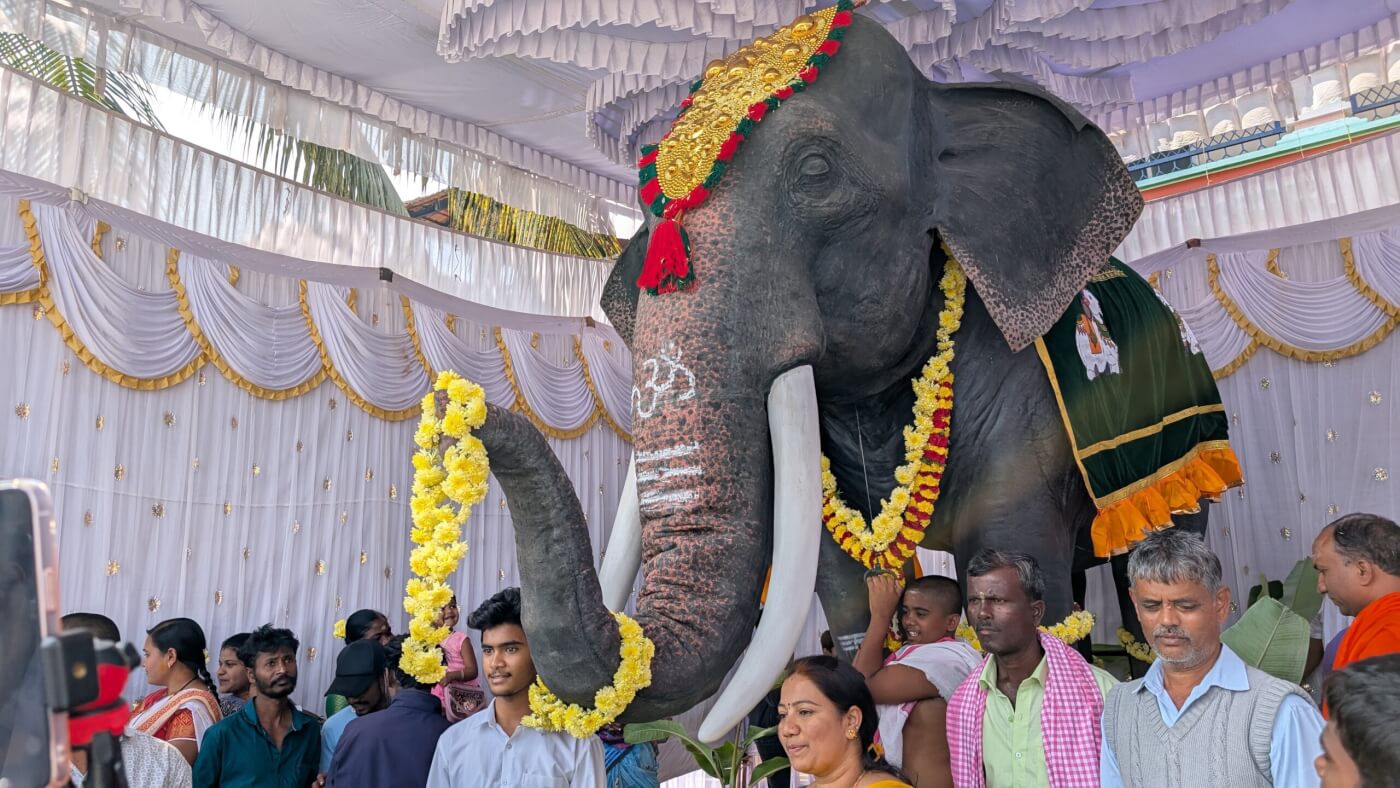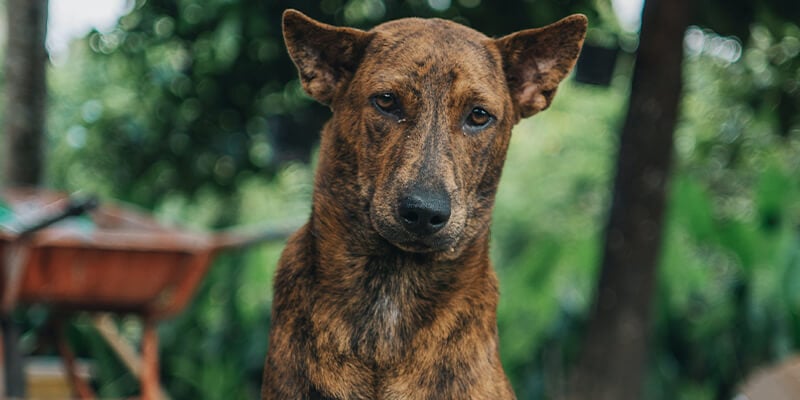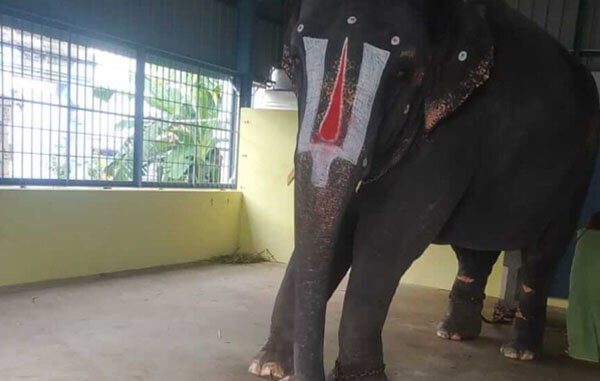Karnataka Ministers Attend Launch of Mechanical Elephant at Shri Jagadguru Renukacharya Temple in Chikkamagaluru Gifted by Actor Shilpa Shetty Kundra, PETA India and CUPA
In celebration of the centenary birth ceremony of Shrimad Rambhapuri Veerarudramuni Jagadguru, Honorable Karnataka Minister of Forest, Ecology and Environment Shri. Eshwar B Khandre and Honorable Karnataka Minister of Energy Shri. K. J. George attended the launch of a life-size mechanical elephant, Veerabhadra, at the Shri Jagadguru Renukacharya Temple at the Rambhapuri Peetha in recognition of the temple’s decision never to own or hire live elephants. Veerabhadra was donated by renowned actor and entrepreneur Shilpa Shetty Kundra, along with non-governmental organisations PETA India and Compassionate Unlimited Plus Action (CUPA). Veerabhadra was welcomed to the temple through an inauguration ceremony, followed by a Mangala Vadhyam performance. Shri Jagadguru Renukacharya Temple at the Rambhapuri Peetha is the first temple in the district of Chikkamagaluru to have this technology. Veerabhadra will be used to conduct ceremonies at the temple safely and cruelty-free, helping real elephants stay with their families in the jungle.
PETA India’s Hero to Animals award recipient, Shilpa Shetty Kundra, says, “Mechanical elephants allow us to revere real elephants as God intended, free in their jungle homes. I am truly elated to join hands with PETA India and CUPA in enabling devotees to participate in festivals safely and cruelty-free with the help of this mechanical elephant. What an innovative, noble thought.”
Appreciating the efforts of PETA India and CUPA in donating mechanical elephants to temples, Chief Swamiji of the Peetha, Shri Rambhapuri Jagadguru, says, “We are incredibly pleased to welcome this mechanical elephant, Veerabhadra, who will enable us to perform our festivals and ceremonies in an animal-friendly and safe manner. We encourage more temples and mutts to join us by welcoming a mechanical elephant.”
Honorable Karnataka Minister of Forest, Ecology and Environment, Shri. Eshwar B Khandre, “Many other temples and mutts have requested me to donate an elephant. But as per the Wildlife Protection Act, 1972, we cannot donate elephants to any other temple. Under these circumstances, new technologies have come, like Shilpa Shetty Kundra, PETA India and CUPA donated Veerbhadra, the robotic elephant to Shri Jagadguru Renukacharya Temple at the Rambhapuri Peetha. I would like to congratulate PETA India on behalf of the forest department and Karnataka government and give a message to the public to conserve elephants and wildlife. It’s the need of the hour, and they have a right to live on this Earth.”
Member of the Legislative Assembly of Sringeri, Mr. T.D. Rajegowda says, “Replacing real elephants with mechanical elephants is needed to conserve and protect our country’s wildlife and to protect devotees from being harmed by frustrated elephants.”
Elephants are smart, active, and gregarious wild animals. In captivity, they are trained to be used in processions through beatings, the use of weapons and force. Most elephants held captive in temples and other places suffer from excruciating foot problems and leg wounds due to chaining to concrete for hours on end. Most are denied adequate food, water, veterinary care, and any semblance of a natural life. Under these hellish conditions, many elephants become intensely frustrated and lash out, sometimes killing mahouts or other humans or animals. According to figures compiled by the Heritage Animal Task Force, captive elephants killed 526 people in Kerala in 15 years. Thechikkottukavu Ramachandran, who has been in captivity for about 40 years and is one of the most often used elephants in Kerala’s festival circuit, has reportedly killed 13 individuals – six mahouts, four women, and three elephants.
PETA India ignited the sympathetic movement of replacing live elephants in temples at the beginning of 2023 through a donation of a mechanical elephant to Irinjadappilly Sri Krishna Temple in Thrissur, Kerala, with the help of actor Parvathy Thiruvothu. Now, at least ten mechanical elephants are used in temples across south India, of which PETA India donated six. Mechanical elephants are 3-meter-tall and weigh 800 kilograms. They are made with rubber, fiber, metal, mesh, foam, and steel, and run on five motors. A mechanical elephant looks, feels, and can be used like a real elephant. It can shake its head, move its ears and eyes, swish its tail, lift its trunk, and even spray water. They can be climbed upon, and a seat can be affixed on the back. They can be operated simply by plugging and playing with electricity. They can be taken through the streets and are mounted on a wheelbase, allowing them to be moved and pushed around for rituals and processions.
View this post on Instagram
Shri Jagadguru Renukacharya Temple, Rambhapuri Peetha, in the Chikkamagaluru district of Karnataka, is an ancient temple and an eminent pilgrimage centre. Shri Jagadguru Renukacharyaji, who sprang from Someshwar Linga at Kollipaki in Andhra Pradesh, established the Balehonnur Peetha in Karnataka, and this is the first among the Pancha Mahapeethas of Veerashaivism. The Balehonnur Peetha is in the Chikkamagalur District, Karnataka, popularly known as the Kashmir of Karnataka due to its natural scenic beauty.
Help Elephants from Cruel Performances










